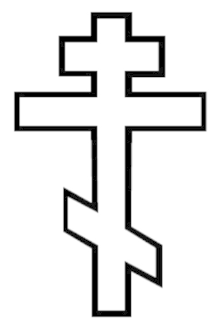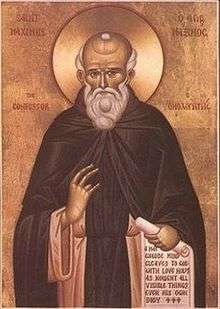December 19 (Eastern Orthodox liturgics)
December 18 - Eastern Orthodox liturgical calendar - December 20
All fixed commemorations below celebrated on January 1 by Orthodox Churches on the Old Calendar.[note 1]
For December 19th, Orthodox Churches on the Old Calendar commemorate the Saints listed on December 6.
Saints
- Martyr Boniface of Tarsus, at Tarsus in Cilicia (290)[1] and Righteous Aglae (Aglais, Aglaida) of Rome.[2] (c. 303)[3]
- Martyrs Elias, Probus, and Ares the Egyptians, in Cilicia (308)[4][note 2]
- Martyrs Polyeuctus at Caesarea in Cappadocia, and the Deacon Timothy at Mauretania, by fire (309)[6]
- Martyrs Eutychios and Thessaloniki, and with them 200 men and 70 women, by the sword.[7][8]
- Martyr Tryphon, by hanging.[9]
- Hieromartyr Capito (Capiton), Bishop of Cherson (4th century)[8][10]
- Saint Gregentios of Himyaritia (Gregentius of Himyar,[11] Gregentios of Taphar,[12] Gregory of Omirits[13]), Missionary Archbishop of Zafar (capital of the Himyarite tribal confederacy) (552)[8][14][note 3][note 4]
- Saint Boniface the Merciful, Bishop of Ferentino (6th century)[8][16]
- Saints George the Scribe, and Sabbas, monks of Khakhuli Monastery (11th century)[8][17]
Pre-Schism Western saints
- Saint Fausta of Sirmium, the mother of St Anastasia of Sirmium (3rd century)[18]
- Saint Anastasius I, Pope of Rome (401)[18][note 5]
- Saint Avitus (or Adjutus), Abbot of Micy near Orleans in France, an abbot renowned for the spirit of prophecy.[18][19]
- Saint Gregory of Auxerre, the twelfth bishop of Auxerre in France and Confessor (c. 540)[18]
- Saint Ribert (Ribarius), seventeenth Abbot of Saint-Oyend in France, he is venerated in Franche-Comté (c. 790)[18]
- Saint Manirus of Scotland, one of the Apostles of the north of Scotland (824).[18][20][21]
Post-Schism Orthodox saints
- Venerable Elias of Murom, Wonderworker of the Kiev Caves (1188)[8][22][23][note 6]
- Saint Seraphim (Romantsov), Schema-Archimandrite of Sukhumi, Abkhazia, Elder of Glinsk Monastery (1975)[8]
Other commemorations
Icon gallery
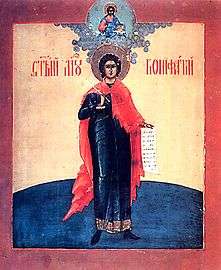
.jpg) Martyr Polyeuctus, at Caesarea in Cappadocia (Menologion of Basil II, 10th century).
Martyr Polyeuctus, at Caesarea in Cappadocia (Menologion of Basil II, 10th century)..jpg) Martyr Timothy the Deacon, in Mauretania (Menologion of Basil II, 10th century).
Martyr Timothy the Deacon, in Mauretania (Menologion of Basil II, 10th century).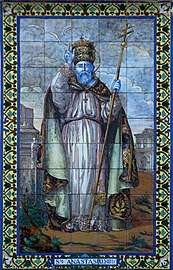 Ceramic altarpiece with St. Anastasius I, Pope of Rome (1923).
Ceramic altarpiece with St. Anastasius I, Pope of Rome (1923).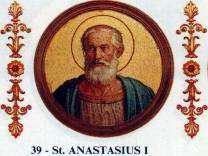 St. Anastasius I, Pope of Rome
St. Anastasius I, Pope of Rome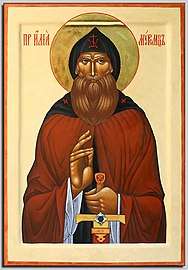 St. Elias of Murom (Ilya Muromets).
St. Elias of Murom (Ilya Muromets).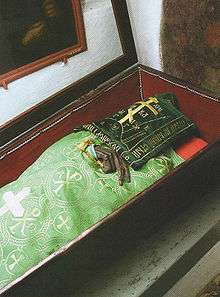 The relics of St. Elias of Murom (Ilya Muromets).
The relics of St. Elias of Murom (Ilya Muromets).
Notes
- The notation Old Style or (OS) is sometimes used to indicate a date in the Julian Calendar (which is used by churches on the "Old Calendar").
The notation New Style or (NS), indicates a date in the Revised Julian calendar (which is used by churches on the "New Calendar"). - The Martyrs Elias, Probus and Ares, natives of Egypt, and heedless of their own safety, cared for Christians locked up in prison during the persecution of Maximian (305-313). For this they were arrested, subjected to torture and given over to death (+ 308).[5]
- "At first, Gregory was a deacon in a church in Mediolanum [Milan] and had many visions. By God's providence he was taken to Alexandria. There Patriarch Proterius, according to a heavenly revelation, consecrated him Bishop of the land of Omir (Himyaritia) in southern Arabia, which St. Elesbaan the King (October 24) had just freed from the tyranny of Dunaan the Jew. He was a good shepherd and great miracle-worker. He organized the Church in Omir with the help of the Christ-loving King Abramius, built many churches, and baptized many Jews. By his prayers he performed great and awesome miracles, even bringing about a revelation of Christ the Lord before the unbelieving Jews, which led to their baptism. He governed the Church for thirty years and entered peacefully into life eternal in the year 552."[15]
- (in Greek): "Ὅταν χήρεψε ἡ ἐπισκοπὴ Αἰθιοπίας, ὁ βασιλιὰς Ἐλεσβαᾶν ζήτησε ἀπὸ τὸν Πατριάρχη Ἀλεξανδρείας νὰ τοῦ στείλει ἐπίσκοπο μορφωμένο καὶ ἐνάρετο. Τότε ὁ Πατριάρχης ἐξέλεξε τὸν Γρηγέντιο, ὁ ὁποῖος ἐπετέλεσε τὴν ἀποστολή του μὲ πολὺ ζῆλο καὶ μεγάλη καρποφορία. Στὸν τόπο αὐτὸ ἦταν πολλοὶ Ἑβραῖοι καὶ ἦταν φανατικὰ προσκολλημένοι στὴ θεωρία τους. Ἕνας μάλιστα δεινὸς συζητητὴς ἀπ’ αὐτούς, ἦταν καὶ ὁ Ραβῖνος Ἐρβᾶς. Ἀλλὰ ὁ Γρηγέντιος, μὲ τὰ σοφὰ ἐπιχειρήματά του, τὴν ἀγαθότητά του καὶ μὲ τὴ θεία χάρη, κατόρθωσε νὰ φέρει στοὺς κόλπους τῆς Ἐκκλησίας τοὺς περισσότερους Ἑβραίους τοῦ τόπου καὶ τὸν ἴδιο τὸν Ἐρβᾶ, ποὺ βαπτίστηκε παρουσία τοῦ βασιλιὰ καὶ μετονομάστηκε Λέων καὶ τιμήθηκε μὲ τὸ ἀξίωμα τοῦ Πατρικίου. Ὁ διάδοχος τοῦ Ἐλεσβαᾶν, γιὸς τοῦ Ἔρδιδος, συνέχισε τὴν ἴδια πολιτικὴ εὐλάβειας πρὸς τὸν Γρηγέντιο. Ὁ Γρηγέντιος πέθανε εἰρηνικὰ στὶς 19 Δεκεμβρίου 552 καὶ τὴν στέρησή του, θρήνησε πολὺς κόσμος."[14]
- Pope of Rome and a man of poverty and the apostolic mind, he stopped the spread of Origenism at a Council held in 400.
- "The Monk Ilya Muromets of Pechersk, nicknamed "Chobotok" ("Shoemaker" or "Cobbler"), was from the city of Murom, and popular legend identifies him with the famous bogatyr-warrior hero Ilya Muromets, about whom were sung Russian byliny‑ballads. About the Monk Ilya is known, that he died with the fingers of his right hand formed for prayer in the position accepted even today in the Orthodox Church – the first three fingers together, and the two outermost last fingers contracted into the palm [in contrast to the hand formation in making the sign of the Cross used by the "Old Ritualist" "Staroverie" "Old Believers"]. In the period of the struggle with the Old Ritualist ("Staroobryadnyi") Schism (end of the 17th - 19th century), this fact from the life of the saint served as a powerful proof in the useage of the present hand formation."[24]
gollark: It's not an optimisation. This was just an accident.
gollark: I use a fairly wide monitor and do tons of oneliners.
gollark: So database logic goes in one file, arbitrary utility stuff in another, and the rest on a giant main file, for example.
gollark: I generally split out things by function somewhat.
gollark: Nim has a great* culture of multiple thousand line code files.
References
- Martyr Boniface at Tarsus, in Cilicia. OCA - Feasts and Saints.
- Righteous Aglaida (Aglae) of Rome. OCA - Feasts and Saints.
- Great Synaxaristes: (in Greek): Οἱ Ἅγιοι Βονιφάτιος καὶ Ἀγλαΐα ἡ Ρωμαία. 19 Δεκεμβρίου. ΜΕΓΑΣ ΣΥΝΑΞΑΡΙΣΤΗΣ.
- Great Synaxaristes: (in Greek): Οἱ Ἅγιοι Ἠλίας, Πρόβος καὶ Ἄρης οἱ Μάρτυρες. 19 Δεκεμβρίου. ΜΕΓΑΣ ΣΥΝΑΞΑΡΙΣΤΗΣ.
- Martyr Elias in Cilicia. OCA - Feasts and Saints.
- Great Synaxaristes: (in Greek): Οἱ Ἅγιοι Τιμόθεος καὶ Πολύευκτος οἱ Μάρτυρες. 19 Δεκεμβρίου. ΜΕΓΑΣ ΣΥΝΑΞΑΡΙΣΤΗΣ.
- Great Synaxaristes: (in Greek): Οἱ Ἅγιοι Εὐτύχιος, Θεσσαλονίκη, 200 Ἄνδρες καὶ 70 Γυναῖκες οἱ Μάρτυρες. 19 Δεκεμβρίου. ΜΕΓΑΣ ΣΥΝΑΞΑΡΙΣΤΗΣ.
- December 19/January 1. Orthodox Calendar (PRAVOSLAVIE.RU).
- Great Synaxaristes: (in Greek): Ὁ Ἅγιος Τρύφων ὁ Μάρτυρας. 19 Δεκεμβρίου. ΜΕΓΑΣ ΣΥΝΑΞΑΡΙΣΤΗΣ.
- January 1 / December 19. HOLY TRINITY RUSSIAN ORTHODOX CHURCH (A parish of the Patriarchate of Moscow).
- Saint Gregentius, Bishop of Himyar. Macedonian Orthodox Church - Archdiocese of Ohrid.
- Albrecht Berger (Ed.). Life And Works of Saint Gregentios, Archbishop of Taphar. Millennium Studies 7. Walter de Gruyter, Tra edition, October 30, 2006. 915 pp. ISBN 9783110184457
- St Gregory the Archbishop of Omirits. OCA - Feasts and Saints.
- Great Synaxaristes: (in Greek): Ὁ Ὅσιος Γρηγέντιος Ἐπίσκοπος Αἰθιοπίας. 19 Δεκεμβρίου. ΜΕΓΑΣ ΣΥΝΑΞΑΡΙΣΤΗΣ.
- Bishop Nikolai Velimirovch. The Prologue from Ohrid. Serbian Orthodox Church Diocese of Western America.
- St Boniface the Merciful the Bishop of Ferentino. OCA - Feasts and Saints.
- Venerable George the Scribe, of Khakhuli. OCA - Feasts and Saints.
- December 19. Latin Saints of the Orthodox Patriarchate of Rome.
- The Roman Martyrology. Transl. by the Archbishop of Baltimore. Last Edition, According to the Copy Printed at Rome in 1914. Revised Edition, with the Imprimatur of His Eminence Cardinal Gibbons. Baltimore: John Murphy Company, 1916. p.390.
- St. Manire of Scotland // Celtic and Old English Saints
- Den hellige Manirus av Skottland (d. 824) // Den Katolske Kirke
- Venerable Elias of Murom the Wonderworker of the Kiev Near Caves. OCA - Feasts and Saints.
- Great Synaxaristes: (in Greek): Ὁ Ὅσιος Ἡλιοῦ Μουρόμας ὁ Θαυματουργός ὁ ἐν τῷ Σπηλαίῳ (Ρῶσος). 19 Δεκεμβρίου. ΜΕΓΑΣ ΣΥΝΑΞΑΡΙΣΤΗΣ.
- The Monk Ilya Muromets of Pechersk. HOLY TRINITY RUSSIAN ORTHODOX CHURCH (A parish of the Patriarchate of Moscow).
Sources
- December 19/January 1. Orthodox Calendar (PRAVOSLAVIE.RU).
- January 1 / December 19. HOLY TRINITY RUSSIAN ORTHODOX CHURCH (A parish of the Patriarchate of Moscow).
- December 19. OCA - The Lives of the Saints.
- The Autonomous Orthodox Metropolia of Western Europe and the Americas (ROCOR). St. Hilarion Calendar of Saints for the year of our Lord 2004. St. Hilarion Press (Austin, TX). p. 1.
- December 19. Latin Saints of the Orthodox Patriarchate of Rome.
- The Roman Martyrology. Transl. by the Archbishop of Baltimore. Last Edition, According to the Copy Printed at Rome in 1914. Revised Edition, with the Imprimatur of His Eminence Cardinal Gibbons. Baltimore: John Murphy Company, 1916.
Greek Sources
- Great Synaxaristes: (in Greek) 19 ΔΕΚΕΜΒΡΙΟΥ. ΜΕΓΑΣ ΣΥΝΑΞΑΡΙΣΤΗΣ.
- (in Greek) Συναξαριστής. 19 Δεκεμβρίου. ECCLESIA.GR. (H ΕΚΚΛΗΣΙΑ ΤΗΣ ΕΛΛΑΔΟΣ).
Russian Sources
- (in Russian) 1 января (19 декабря). Православная Энциклопедия под редакцией Патриарха Московского и всея Руси Кирилла (электронная версия). (Orthodox Encyclopedia - Pravenc.ru).
- (in Russian) 19 декабря (ст.ст.) 1 января 2013 (нов. ст.). Русская Православная Церковь Отдел внешних церковных связей. (DECR).
This article is issued from Wikipedia. The text is licensed under Creative Commons - Attribution - Sharealike. Additional terms may apply for the media files.
